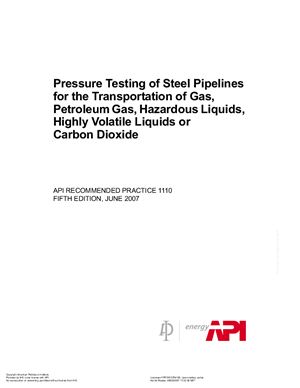30 стр.
American Petroleum Institute, Fifth Edition, June 2007
This Recommended Practice (RP) provides guidelines for pressure testing steel pipelines for the transportation of gas, petroleum gas, hazardous liquids, highly volatile liquids or carbon dioxide. The RP provides guidance so that:
a. Pipeline operators can select a pressure test suitable for the conditions under which the test will be conducted. This includes, but is not limited to, pipeline material characteristics, pipeline operating conditions, and various types of anomalies or other risk factors that may be present.
b. Pressure tests are planned in order to meet the overall objectives of the pressure test.
c. Site-specific procedures are developed and followed during all phases of the pressure testing process.
d. Pressure tests consider both personnel safety and environmental impacts.
e. Pressure tests are implemented by qualified personnel.
f. Pressure tests are conducted in order to meet stated acceptance criteria and pressure test objectives.
g. Pressure test records are developed, completed and retained for the useful life of the facility.
Users of this RP should be aware that further or differing requirements may be necessary for some applications. Nothing in this
RP is intended to inhibit the use of engineering solutions that are not covered by the RP. This may be particularly applicable where there is innovative developing technology. Where an alteative is offered, the RP may be used, provided any and all variations from the RP are identified and documented.
American Petroleum Institute, Fifth Edition, June 2007
This Recommended Practice (RP) provides guidelines for pressure testing steel pipelines for the transportation of gas, petroleum gas, hazardous liquids, highly volatile liquids or carbon dioxide. The RP provides guidance so that:
a. Pipeline operators can select a pressure test suitable for the conditions under which the test will be conducted. This includes, but is not limited to, pipeline material characteristics, pipeline operating conditions, and various types of anomalies or other risk factors that may be present.
b. Pressure tests are planned in order to meet the overall objectives of the pressure test.
c. Site-specific procedures are developed and followed during all phases of the pressure testing process.
d. Pressure tests consider both personnel safety and environmental impacts.
e. Pressure tests are implemented by qualified personnel.
f. Pressure tests are conducted in order to meet stated acceptance criteria and pressure test objectives.
g. Pressure test records are developed, completed and retained for the useful life of the facility.
Users of this RP should be aware that further or differing requirements may be necessary for some applications. Nothing in this
RP is intended to inhibit the use of engineering solutions that are not covered by the RP. This may be particularly applicable where there is innovative developing technology. Where an alteative is offered, the RP may be used, provided any and all variations from the RP are identified and documented.

